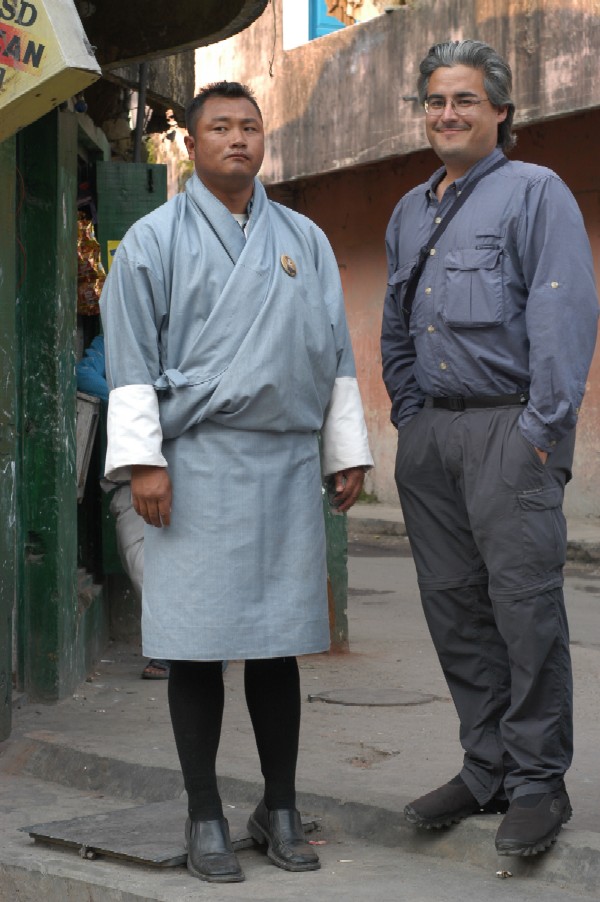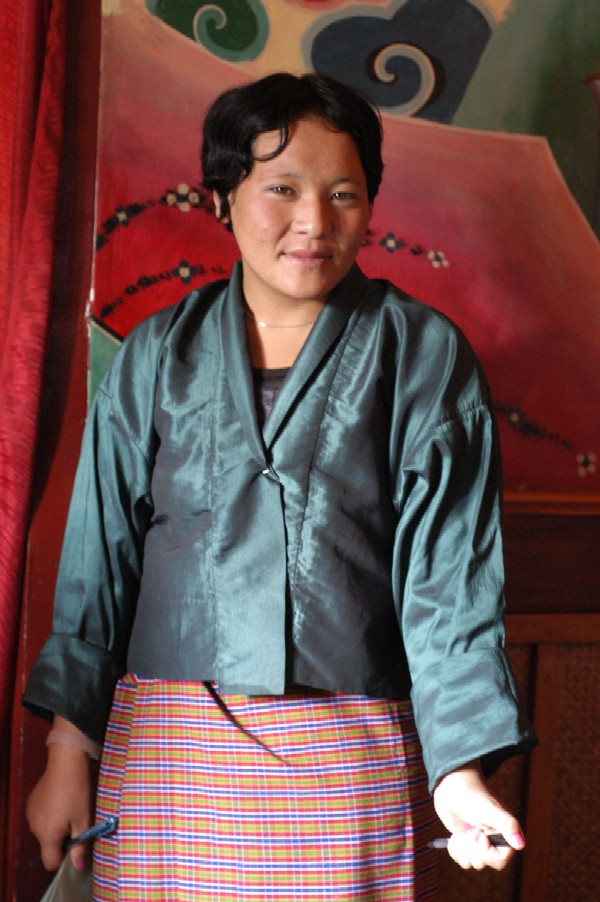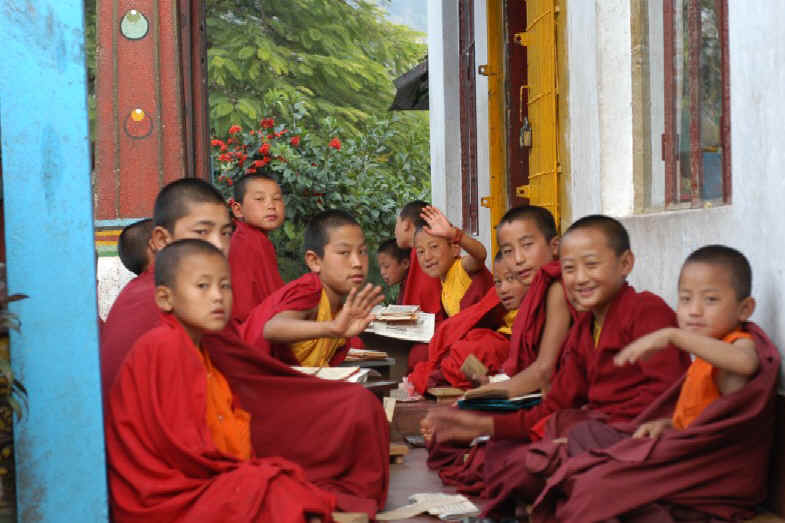January 4. JAIGON/PHUENTSHOLING (BHUTAN) "Straddling the Border of India and Bhutan"The Indian border town of Jaigon is married to the Bhutanese border town of Phuentsholing. Phentsholing is the only place where a tourist can visit Bhutan without investing in a $200/day tourist fee but the curfew for being out of the country is 10:00 at night. Popping into Bhutan had intrigued us for a while, especially Rob who figured it was just too close not to touch. The Tibetan owner of one of our restaurants in Darjeeling had spent years living in Bhutan, when her family was exiled from Tibet, but said there was nothing to see in Phuentsholing. Her family eventually left because of Bhutan's increasingly strict policies like mandatory traditional dress, even if you weren't ethnically Bhutanese, and no television. Still, our curiosity was peaked. Border towns are never a country's highlight and sometimes a totally unique cultural phenomena but they can give a small glimpse into the next country.
Our hotel told us we could catch the bus to Jaigon behind our hotel but there was nothing behind our hotel except for a dead end. It was early and there was nobody around so Rob ran back to get more specific directions. It turned out there was a narrow alleyway off of one corner that we hadn't seen. The far end of the alley opened up to a taxi and bus area. We were fortunate to find a bus that was just about full, heading towards Jaigon. They said we would have to go a bit farther but that we were on the right bus. We weren't sure what they meant but decided we would figure it out. We didn't want to waste time looking for other bus options  since we only had one day to visit Phuentsholing. We Stuffed ourselves and our bags into the back seat of the bus and paid for four seats. since we only had one day to visit Phuentsholing. We Stuffed ourselves and our bags into the back seat of the bus and paid for four seats.
The bus ride moved along nicely and we were making good time until we were instructed to get off of the bus. We had reached a transfer point, which is what they must have meant, and had to grab our bags and run for the next bus. Getting on a bus mid route with bags was usually a hassle but we lucked out again with plenty of space on the other bus as well. It wasn't much farther to Jaigon. The bus station was pretty large, with proper bus stalls and everything, but it was on the outside of town. We checked with a guy inside the station about how far it was to into town and he said far so we hopped a tuk tuk and headed for the Hotel Kasturi, the only recommendation that we had. We passed through much of Jaigon before we reached the hotel, very glad we hadn't opted to walk. The Hotel Kasturi was only a few hundred feet from the border and the rooms were decent, very sparse and simple but clean enough, and the people that ran it were nice. We chucked our bags in the room and headed out directly for Phuentsholing.
The border was marked by a large decorative gate. There wasn't a real checkpoint set up but there were guards, some in traditional Bhutanese dress, lined up at the entrance to look people over and check passports. They took a look at ours and let us through. The difference between Jaigon and Phuentsholing was quite dramatic. Jaigon was a dirtball of a place while Phentsholing had tall decorated buildings and neatly paved roads. The local people seemed to move back and forth across the border without much scrutiny. It all looked pretty relaxed for a country with such strict tourist policies.
After traveling all morning our first priority was to find some food. We took a sweep around the middle of town, past the new gompa, and didn't see many options. In the end we went back to a hotel right next to the gate. It was a bit early for lunch so they were just opening up. The hostess was dressed in traditional Bhutanese clothing which had its own unique style. She wore a short blue silk jacket over her long plaid. Underneath they used silver medallions to attach the dress at the shoulders. We had some hearty noodles and dumplings before heading off to complete our "errands". Rob wanted to visit the bank and I wanted to look for pins and we both wanted to send some postcards. so they were just opening up. The hostess was dressed in traditional Bhutanese clothing which had its own unique style. She wore a short blue silk jacket over her long plaid. Underneath they used silver medallions to attach the dress at the shoulders. We had some hearty noodles and dumplings before heading off to complete our "errands". Rob wanted to visit the bank and I wanted to look for pins and we both wanted to send some postcards.
Most of Pheuntsholing was clustered against the border the buildings were mostly shops or hotels. We couldn't stay at the local hotels without a visa but they looked a tad nicer than the place we were staying in Jaigon. Around the square where the temple stood there were numerous textile shops. The typical Bhutanese textiles were colorful striped and plaid designs but they were no longer made in Bhutan. Most of the textile shops looked like they were run by Indians. The national bank and post office were farther up the hill, away from the border area, in a more residential part of town. A guy at the taxi queue area gave us directions. They turned out to be right across the street from each other so I went to the post office while Rob went to the bank. When I asked if they sold any postcards (usually a long shot) I was surprised to get invited into a nearby office. It looked like I was getting service from the bank manager, probably the one who spoke the most English, who pulled out a stack of cards for me to look through. I selected a few and quickly filled them out. Rob took a little longer with his task. He didn't find any new bills but the bank clerk kindly searched for the best ones that he had. My search for pins wasn't fruitful but got us to investigate a wide range of shops around town. We stopped briefly for a cake snack in one shopping center and found a small shop sellin g souvenirs, but clearly Phuentsholing wasn't set up to cater to cultural tourists. Indians could enter Bhutan without a visa so perhaps they used the hotels but more likely they were used by Bhutanese who came down to the border to stock up on more readily available goods. We were the only western tourists that we saw in Pheuntsholing and we drew a little bit of attention. The Bhutanese were so very nice and many maintained the traditional dress, in spite the relaxing laws in that regard. Most people we asked for a photo were happy to oblige but they were shy. Rob chatted for a bit with a local policeman who even agreed to pose with him for a photo. g souvenirs, but clearly Phuentsholing wasn't set up to cater to cultural tourists. Indians could enter Bhutan without a visa so perhaps they used the hotels but more likely they were used by Bhutanese who came down to the border to stock up on more readily available goods. We were the only western tourists that we saw in Pheuntsholing and we drew a little bit of attention. The Bhutanese were so very nice and many maintained the traditional dress, in spite the relaxing laws in that regard. Most people we asked for a photo were happy to oblige but they were shy. Rob chatted for a bit with a local policeman who even agreed to pose with him for a photo.
Before it got too late we hired a taxi to take us up the hill behind Pheuntsholing to visit a more remote gompa. It was as far as we were permitted to go without a visa but as we drove and drove up the hill we both began to wonder if that was really that case. The gompa was much farther than we expected. It was a small monastery compared to others we had seen but was perched high on a cliff that looked over Jaigon. As we approached we saw a group of teenaged monks laying out their robes to dry on the bushes. One wore a shirt with what looked like a team name written on it but it was still that deep burgundy color so they must have let it slide. Around the front of the gompa we looked down at the sprawl of dusty Jaigon. The difference in landscape between Bhutan and India was striking. As we stood on the edge of a lush densely vegetated mountain, far below it was flat as far as we could see to the south. Here the mountains provided a clear delineation between Bhutan and India, giving the Bhutanese a fortress of a country. We walked quietly around the monastery and saw monks chanting in the small main hall. When they finished we took a quick peek inside but soon a group of younger monks assembled on the porch in front of the monastery and began chanting together. They were holding texts and glancing at them but were easily distracted. They kept an eye on us and even in the process of their rote recitation managed to giggle at us and wave at our cameras. The main hall faced to the north west but we walked along the ridge to the far side of the monastery complex and saw just how far Jaigon stretched. There were surely more people living in Jaigon than in Phuentsholing. A cluster of prayer flags flapped in the wind and the sun was slowly setting behind them. Toward the back of the complex, near the parking lot, we found some livestock and local caretakers. Strips of meat were hung on a line to dry. When we got back in our taxi the van wouldn't start. Maybe our driver had been playing the radio too much, so Rob got out to help give him a push and it started. small main hall. When they finished we took a quick peek inside but soon a group of younger monks assembled on the porch in front of the monastery and began chanting together. They were holding texts and glancing at them but were easily distracted. They kept an eye on us and even in the process of their rote recitation managed to giggle at us and wave at our cameras. The main hall faced to the north west but we walked along the ridge to the far side of the monastery complex and saw just how far Jaigon stretched. There were surely more people living in Jaigon than in Phuentsholing. A cluster of prayer flags flapped in the wind and the sun was slowly setting behind them. Toward the back of the complex, near the parking lot, we found some livestock and local caretakers. Strips of meat were hung on a line to dry. When we got back in our taxi the van wouldn't start. Maybe our driver had been playing the radio too much, so Rob got out to help give him a push and it started.
Before heading back over to Jaigon we had dinner at the same cafe. Ordered a meat dish with creamy cheese sauce while Rob had a stew. It wasn't spectacular food but hearty and tasty. |

